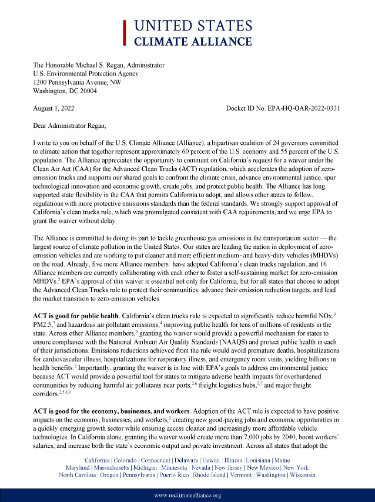Home / U.S. Climate Alliance Requests EPA Approval of California’s Clean Trucks Waiver
- Letter
U.S. Climate Alliance Requests EPA Approval of California's Clean Trucks Waiver
August 1, 2022
The Alliance has long supported state flexibility in the Clean Air Act (CAA) that permits California to adopt, and allows other states to follow, regulations with more protective emissions standards than the federal standards. We strongly support approval of California’s clean trucks rule, which was promulgated consistent with CAA requirements, and we urge EPA to grant the waiver without delay.
The Alliance is committed to doing its part to tackle greenhouse gas emissions in the transportation sector — the largest source of climate pollution in the United States. Our states are leading the nation in deployment of zero-emission vehicles and are working to put cleaner and more efficient medium- and heavy-duty vehicles (MHDVs) on the road. Already, five more Alliance members have adopted California’s clean trucks regulation, and 16 Alliance members are currently collaborating with each other to foster a self-sustaining market for zero-emission MHDVs.
EPA’s approval of this waiver is essential not only for California, but for all states that choose to adopt the Advanced Clean Trucks rule to protect their communities, advance their emission reduction targets, and lead the market transition to zero-emission vehicles.
About the Alliance
Launched on June 1, 2017 by the governors of Washington, New York, and California to help fill the void left by President Trump’s initial decision to withdraw the U.S. from the Paris Agreement, the Alliance has grown to include 24 governors from across the U.S. representing approximately 60% of the U.S. economy and 55% of the U.S. population. Governors in the Alliance have pledged to collectively reduce net greenhouse gas emissions by at least 26-28% by 2025, 50-52% by 2030, and 61-66% by 2035, all below 2005 levels, and collectively achieve overall net-zero greenhouse gas emissions as soon as practicable, and no later than 2050.
The Alliance’s states and territories will continue to advance innovative and impactful climate solutions to grow the economy, create jobs, and protect public health, and have a long record of action and results. In fact, the Alliance reduced its collective net greenhouse gas emissions by 19% between 2005 and 2022, while increasing collective GDP by 30%, and is on track to meet its near-term climate goal by reducing collective GHG emissions 26% below 2005 levels by 2025. The coalition’s states and territories are employing more workers in the clean energy sector, achieving lower levels of dangerous air pollutants, and preparing more effectively for climate impacts and executing more pre-disaster planning than the rest of the country.
###
